July 26, 2000
Combating Terrorism: Assessing Threats, Risk Management, and Establishing Priorities
Congressional testimony by John Parachini
Before the House Subcommittee on National Security,
Veterans Affairs, and International Relations
I want to thank you, other committee members, and your staff for inviting me to share my views on how the United States assesses the threat posed by terrorism and allocates its resources to meet it. The United States government has moved rapidly to address the dangers posed by new trends in terrorism that emerged in the last decade. With local responder training ongoing in many cities around the nations, the establishment of the Joint Task Force, and a number of important R&D program underway, now is an appropriate time to review national efforts and make improvements where necessary.
While I believe the United States has made great strides in recent years to enhance federal, state and local capabilities to combat terrorism, particularly terrorist use of weapons of mass destruction (WMD), I am concerned that many of the efforts launched in the mid-1990s need to be reconsidered. I particularly fear that our national anxiousness to address the so-called “New Terrorism” may be inadvertently adding to the danger. As a result, we are spending big, but not spending smart (See Figure 1). There clearly are new trends in terrorist behavior. But we must make sure that we are drawing accurate lessons from the past and guarding against future developments that are credibly in the realm of possibility and not merely reflections of our wildest nightmares.
Figure 1: Federal Funding to Combat Terrorism ($ in Millions)
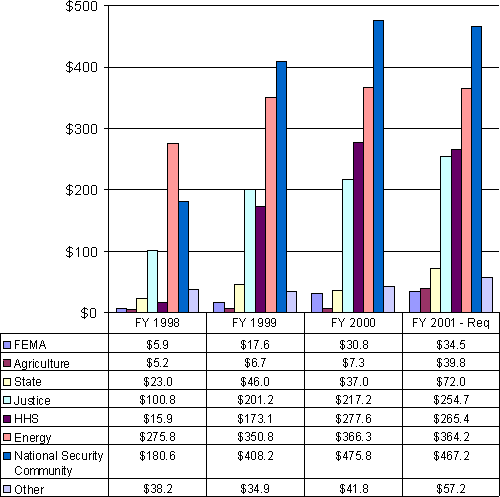
In addition to the committee’s important oversight function, I strongly urge the committee and its staff to engage in a regular dialogue with the executive branch on this issue. As a nation, we are more likely to be most effective in combating the threat of terrorism if a variety of government and private institutions are working on this problem. There are no silver bullets, no special individuals and no single institution for defeating terrorism. To check the threat posed by domestic and international terrorism will require sustained effort by many different entities.
I. Terrorism Threat Assessments and Risk Management Strategies
The United States currently lacks a comprehensive and integrated intelligence assessment to inform policymaker thinking on how to prioritize spending decisions to support the government’s programs to combat terrorism. The General Accounting Office (GAO) has indicated repeatedly that part of the problem with the current executive branch approach to terrorism is the lack of “threat and risk assessments that would suggest priorities and appropriate countermeasures.” [1] The GAO’s observation is extremely important and should be addressed in a serious manner. The importance of the GAO view is that we lack a reasoned basis for making a case that we are spending too little, too much or just enough to combat terrorism. How much is enough remains an open question. As one renowned scholar succinctly noted, “without a firm understanding of the threat based on rigorous, ongoing reviews of evolving or changing terrorist behavior and capabilities, continued efforts to address this problem may prove as ineffective as they are misplaced.” [2]
The last formal National Intelligence Estimate (NIE) on terrorist threats occurred three years ago. While this estimate was broad in scope, it was not intended to serve as a national assessment to assist policymakers in calibrating government efforts and spending decisions. Currently there is no single person who serves as a National Intelligence Officer (NIO) for terrorism. In a de facto fashion, the Director of Center Intelligence’s (DCI) Counterterrorist Center generally serves this role. Given the jurisdictional restraints on the Central Intelligence Agency, the Counterterrorist Center cannot assemble an assessment that combines information on both domestic and international terrorism.
With a security threat as fluid and elusive as terrorism, the challenge of crafting effective short and long term measures is very difficult. Intelligence on terrorist threats is significantly different than intelligence on military threats from nation-states. Intelligence on the military programs of nation-states is comparatively more static and large enough to be covered by a variety of intelligence means. Numerous intelligence assessments on the threat posed by ballistic missiles have been conducted in recent years. [3] Similarly, a number of special commissions have also sought to provide the Congress, the President and the American people with their view of the threat. [4] These assessments have contributed to the national debate on the threat posed by ballistic missiles and the measures that may be required to address the threat. The short and long-term measures addressing the proliferation of ballistic missiles bear significant financial implications for the country.
While the threat posed by terrorism is much more difficult to gauge, analysis of the threat certainly deserves as thorough a review. Several special commissions have contributed to our collective understanding of the threat posed by emerging trends in terrorism, but their mandates have not specifically focused on assessing the threat. What is missing from our national discussion on how to best combat terrorism is a regular, comprehensive threat assessment that integrates assessment of both domestic and international terrorist threats.
Without a regular, comprehensive and integrated threat assessment of the security challenge posed by terrorism, policymakers draw conclusions on raw and finished intelligence information that comes across their desks. Policymakers prioritize spending and programming emphasis via a variety of tools, but intelligence is an essential one. The view of the intelligence community should serve as a critical baseline for the decisions of policymakers.
Policymakers should not assemble the intelligence assessment in a piecemeal and episodic fashion. Rather, policymakers should have the benefit of a regular, comprehensive and integrated terrorism threat assessment that informs both short-term and long-term policy decisions. Moreover, given the transnational and increasingly loose networks of individuals conducting terrorist acts, policymakers must have a picture of both domestic and international terrorist threats. Examining one set of threats in isolation from the other may hinder early identification of key
warning signs.
A regular, comprehensive, and integrated threat assessment will help ensure that intelligence information that withstands the scrutiny of the entire intelligence community informs program and spending decisions. While policymakers can call upon portions of the intelligence community at any given time for information, a regular, comprehensive and integrated community-wide assessment would provide a process and a document that they take into account when making program and spending decisions.
The Congress should consult with the President about modalities for generating a comprehensive and integrated terrorism threat assessment on a regular basis. One option, and the best in my opinion, is to have the Interagency Intelligence Committee on Terrorism conduct a comprehensive and integrated assessment every year or two. Another option is to establish a National Intelligence Officer for terrorism. In order to ensure that the assessment integrated information on foreign terrorism with domestic terrorism, it is worth considering an equivalent officer in the Federal Bureau of Investigation. Given the constitutional restrictions, the FBI’s Counterterrorism Threat Assessment and Warning Unit may be the proper office to charge with stitching together the assessments of foreign and domestic terrorist threats. And finally, a third option and in my opinion the least desirable option, is for the National Security Council to generate an assessment based on the information it reviews from existing intelligence assessments. In a de facto fashion, this is what currently occurs. The only difference is that a formal NSC assessment might accompany the Office of Management and Budget’s Annual Report to Congress on Combating Terrorism.
A regular terrorism threat assessment will lessen the possibility that long-term investment and program decisions are made according to vicissitudes of raw intelligence and ensure that at least on a regular basis there is a community benchmark calibrating the threat. Finally, and importantly, assembling this report on a periodic basis requires appropriate resources to meet the increased tasking on the intelligence community. Too often the intelligence and law enforcement communities are given new responsibilities without the resources to carry them out and they end up pulling resources from other existing duties and stretching personnel beyond desirable limits.
Creating a national strategy to address a threat for which there is not a clear consensus on the magnitude of the threat leaves the task of crafting a strategy without context. In recent years, United States policy to combat the threat of terrorist use of weapons of mass destruction has been driven by perceptions of vulnerability to such attacks rather than the likelihood. A comprehensive threat assessment would presumably factor in capabilities and motivations in addition to vulnerabilities. The inordinate focus of our antiterrorism policy on vulnerabilities and worst-case planning may skew precious federal resources to less critical aspects of the terrorism problem.
The recent scare over the vulnerability of the national monuments is just the most recent example of how the lack of a comprehensive assessment of threat that takes into account the likelihood of an attack can be exploited by government bodies seeking to call attention to their budgetary needs. [5] News reporting on a study conducted by a private contractor for the National Park Services just prior to the our national Independence Day, as hundreds of thousands of Americans planned to visit our national monuments, was a case of threat manipulation for budgetary benefit in the extreme. [6] The release of information from this report just prior to this national holiday and prior to the conclusion of the congressional budget process seems hardly a coincidence. As two private experts pointed out in the news reporting, the National Park Police are not alone in our nation’s Capitol when it comes to protecting the city from terrorist attacks, nor is it possible to completely eliminate all vulnerability. Addressing the communications or overtime needs of the National Park Service should be possible without scaring citizens away from visiting national monuments on Independence Day or unnecessarily drawing attention to vulnerabilities that might be exploited by individuals or groups with malicious designs.
Basing threat perception on vulnerabilities and gearing much of our terrorism response capabilities according to worst-case scenarios is skewing our approach to terrorism. A number of problems stem from a focus on vulnerabilities and worst-case response planning. First, the historical record on terrorism and the intelligence community both suggest that conventional explosives continue to be the weapon of choice for terrorists. [7] Low consequence attacks with multiple-use chemicals and non-contagious biological agents trails behind conventional explosives as the likely weapon of choice. There is a low probability of high consequence attacks that may involve the full range of unconventional weapons materials.
Second, by focusing on the low probability, high consequence events we may tend to categorize too many of them involving unconventional weapons materials as federal events when state and/or local resources may be more appropriate. [8] Given the potential for demands on federal assets to meet American interest abroad as well as at home, they should be saved for when they are appropriately required.
Third, frequent discussion about our vulnerabilities draws attention to them. Most of the WMD cases the FBI investigated in recent years were anthrax hoaxes. Our public communication about the terrorist threat is inadvertently eliciting threats that distract our resources from real attacks by determined terrorists. [9]
Fourth, we must guard against inflating the potential of this threat to such a large degree that we create conflicts between funding for antiterrorism measures at home and important missions for our military abroad. Inordinate concern about catastrophic domestic terrorism may lead policymakers to call upon the military to perform missions at home that should be the domain of non-military service government organizations. Mission dilution of our military is something that constantly warrants the attention of the President and the Congress. We should keep the military’s missions few and well defined such that it can perform at the highest level of effectiveness.
An open society such as ours cannot eliminate completely danger from all aspects of life. Prudent risk assessments will help us reduce the danger and improve our ability to respond in the unlikely event of an attack. We accept risk in many other areas of American society that result in the tragic loss of life. We want to guard against any terrorist attack that not only threatens the lives of our citizens, but also calls into question the authority of our government. This balance can be achieved at acceptable cost bearing in mind some risk.
Both executive and legislative branches of government seek to address the threat posed by catastrophic terrorist attacks. Senior officials say that they will accept criticism for being over-prepared and over-compensating for the threat. [10] Some congressional staff suggest that the political danger of being parsimonious with spending to combat terrorism is too great to do anything but prepare for the worse-case scenario. While some hedge against the unpredictability of the future is commendable, we must not confuse prudent measures with efforts to avoid political blame for failure to take necessary precautions. Government has a responsibility to prepare for unlikely events that could produce catastrophic consequences. However, a balance must be struck between responsible preparedness and mere political hedging.
A comprehensive terrorism threat assessment will presumably be informed by a thorough analysis of past terrorist incidents with unconventional weapons. Far too many policymakers and researchers rendering assessments about terrorist use of unconventional weapons focus on what they imagine terrorists could do, not on what they have done in the past, which leads them to substitute their thinking for that of the terrorists. Acknowledging that history is not a perfect guide to the future and that government has a responsibility to take precautions against even unlikely eventualities, there must be some baseline, some historical context in order to consider potential eventualities.
II. Comprehensive Terrorism Threat Assessment and a National Strategy for Combating Terrorism
A comprehensive terrorism threat assessment is an essential component for crafting a national strategy for combating terrorism. A national strategy should guide the creation of programs and allocations of resources to implement the strategy. The report submitted by the Director of the Office of Management and Budget (OMB) pursuant to section 1051 of the Fiscal Year 1998 National Defense Authorization Act (Public Law 105-85) entitled “Director of the Office of Management and Budget’s Annual Report to Congress on Combating Terrorism – (hereafter, the OMB Annual Report)” provides a useful basis for congressional and public review of the executive branch’s policies and programs. [11] The year 2000 version of this report does describe a sound budget review process. [12] The document as a whole is a considerable improvement over previous versions of the report.
The OMB Annual Report notes that the Clinton administration’s terrorism policy is outlined in Presidential Decision Directives (PDD) 39, 62 and 63 and specific agency guidance such as the Attorney General’s “Five-Year Interagency Counter-Terrorism Plan.” These documents, issued over the course of the last several years, form a basis for a national strategy. The current budget review process described in the OMB annual report is not a substitute for a comprehensive threat assessment. Both a comprehensive threat assessment and a sound budget review process are needed. However, they do not amount to a national strategy. PDD-39 was issued in 1995 shortly after the sarin attack on the Tokyo subway and the bombing of the Murrah Federal Building in Oklahoma City. PDD-62 and PDD-63 were issued in 1999. Each document was prepared at a different time, in reaction to terrorist events or developing circumstances, or designed to address specific policy gaps and meet new circumstances confronting the United States. A collection of policy documents is simply not equivalent to a national strategy like that recommended by the Gilmore commission. [13] If this national security threat is as important as the President and many of his advisors suggest, then a comprehensive strategy is an important roadmap to guide programmatic and budgetary aspects of governmental activities.
III. US Funding to Combat Terrorism
The OMB Annual Report provides a useful basis for congressional and public review of the executive branch’s spending on antiterrorism and counterterrorism. [14] Funding to combat terrorism is difficult to segment into sub-categories, separating funding that specifically addresses WMD from other non-WMD related programs. Undoubtedly there is overlap that requires a judgment call as to which federal dollar spent contributes to a particular activity. The OMB is to be commended for generating this useful document.
Each annual version of the Report prepared by the OMB and submitted to the Congress provides more budgetary detail on US antiterrorism and counterterrorism activities than the previous year’s version. [15] Not only does this high degree of budgetary transparency serve as a modest testament to the strength of the American political system, it creates the basis for congressional and public review that is vital to sustaining a consensus on government policy in this important area of national security.
The 2000 OMB Annual Report states that “information gleaned since the submission of the FY 2001 budget” and the submission of the Report indicates the nature of the terrorism threat has increased. Further explanation of the increased threat in the period — February 2000 to May 2000 — is not provided. The OMB Annual Report argues that this augmented threat is the justification for an amendment to the budget amounting to $235.5 million submitted in conjunction with the report. [16]
How financial resources are allocated serves as a critical indicator of actual, as opposed to declared, policy implementation. The OMB Annual Report is a valuable tool for understanding the direction, scope and dimensions of USG efforts to combat terrorism. However, in order to ensure that these reports serve their full potential in the future, the OMB should strive to be consistent from year to year.
An imperfection in the OMB Annual Reports over the course of the past three years is that the dollar figures described as enacted in past years are not consistent from year to year. Presumably the OMB can account for the discrepancies, by grouping items under the spending category in one report from that of the following year. For example, in the Report’s general mission category of Law Enforcement and Investigative Activities, the 1999 version of the OMB Annual Report indicates that $2.587 billion was enacted in 1999, there was a supplemental appropriation of $350 million, and that the FY 2000 requested amounted to $2.757. [17] Yet, the OMB Annual Report for 2000 indicates that $2.687 was enacted in 1999 and $2.797 was requested. [18] Thus, the 1999 dollar amount for this category plus the supplemental does not equal the amount the 2000 OMB Annual Report indicates as “enacted” in 1999, nor are the “requested” figures equivalent between the two annual reports. The confusions these apparent discrepancies sow must be rectified in future annual reports to Congress.
Clearly defining the spending items under each spending category may be one way to improve the value of these annual reports. Some analysts argue that the only way to truly understand what has been spent from year to year is to examine the Treasury accounts per department and agency. By tracking the spending according to the Treasury accounts the Congress could determine not only how it agreed with the executive branch on how funds would be spent, but also would actually see how the executive branch implemented the spending as directed by annual budget acts.
IV. Important Budget Issues
A constructive dialogue between the President and the Congress on funding to combat terrorism is critical. At present the dialogue seems satisfactory, but there is room for improvement. On the part of the executive branch, the President’s representatives should consult more regularly and transparently with the Congress. On the part of the Congress, the process should be streamlined and rationalized. The plethora of committees with jurisdiction over portions of the budget supporting the government’s programs to address the terrorist threat makes the consultation process cumbersome. The National Commission’s recommendation that the appropriation committees in each house of Congress assign an individual staff member to track funding for combating terrorism is a useful suggestion. [19]
1. Shifting Funding Emphasis to Prevention and Preemption
Tremendous improvements have been made in our national preparedness to respond to mass casualty terrorism incidents, particularly those involving weapons of mass destruction. More progress is required and training of the next generation of local responders and officials at all levels of government will remain an ongoing task. The focused emphasis on improving capabilities to respond to a WMD attack on American soil followed the Tokyo subway attack. At the time, there was tremendous fear that Aum Supreme Truth’s attack marked the start of a new pattern of sub-national terrorist activity involving unconventional weapons. Since the Tokyo subway incident much has been learned about the attack and the cult, which should help recalibrate the magnitude of the danger of sub-national groups and WMD terrorism. [20]
Putting aside the question of whether the US is allocating too little or too much funding to combat terrorism, and considering the figure of $9.3 billion requested by the Clinton administration for Fiscal Year 2001, a shift in programmatic emphasis and funding seems warranted at this stage in the evolution of American terrorism policy. Increasing emphasis should be place on the front end of the problem, by preemption and prevention of attacks, with less emphasis placed on the back end in post-attack consequence management. The OMB Annual Report notes that from 1998 to 2001 spending for preparing for and responding to terrorist acts increased from $126 million to $627 million, an increase of 398%. [21] This shift is particularly relevant for funding relating to WMD terrorism and incident response (See Figure 2). The increase in funding for preparing for and responding to WMD terrorist acts increased from $89 million in 1998 to $566 million three years later, an increase of 536% (See Figure 3). [22] In contrast, funding for law enforcement and investigative activities has increased only $6% over the same period. While the President has asked for significant increases in this area of funding over the last two years, the end result has been only a modest increase.
Figure 2: Funding to Combat WMD Terrorism by Mission Area ($ in Millions)
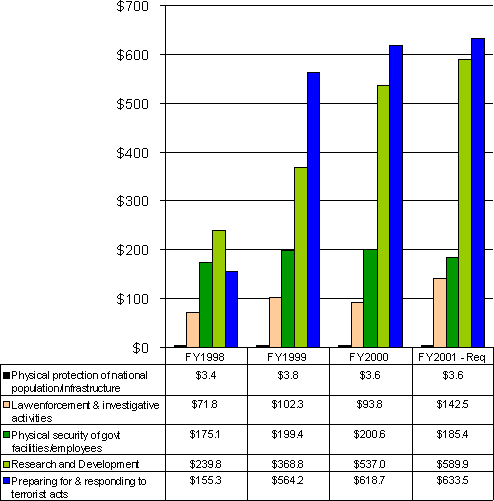
Figure 3: Preparing for and Responding to WMD Terrorism ($ in Millions)
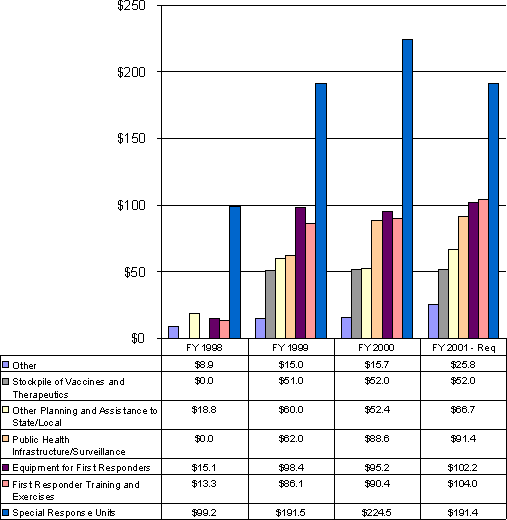
Comparatively modest increases in law enforcement, intelligence and diplomatic tools may dollar per dollar contribute more to diminishing the threat. Using the OMB Annual Report’s language, this means shifting emphasis from downstream investments to upstream investments. Currently, 82% of the funding goes to these downstream investments and 18% to upstream investments. [23] Some downstream investment, such as R&D into pharmaceuticals and improvements in facilities security, may entail huge costs, while more FBI agents and CIA case officers might be comparatively less. Thus, the percentage balance in favor of antiterrorism measures as opposed to counterterrorism measures is understandable. Yet, a comparatively modest shift in funding emphasis would greatly enhance our effort to preempt and prevent attacks, while not neglecting defensive measures.
The law enforcement and intelligence communities perform critical “front end” missions to combat terrorism. While both communities have received extra tasking with the increased concern about the dangers of new terrorist trends, neither has benefited from a sustained increase in funding support to fundamentally change their impact on the problem. Intelligence is the front line of defense against terrorism. The more we know about a security threat from the front line, the more tools we can assemble to address the challenge.
The State Department deserves special mention as a potential tool in the government’s effort to combat terrorism. For comparatively modest amounts of funding the State Department could play a larger role to prevent terrorist attacks. Collaboration with allies to thwart attacks and pressure states that aid terrorism could hem in the problem in important ways. The intelligence community and the Department of Defense can also play an important role by collaborating with their counterparts in foreign countries to thwart attacks before they occur and sap the resources that terrorist group need to wage their attacks. Finally, it may be helpful to establish a separate line item in the State Department for combating terrorism. Currently, funding for terrorism is lumped in with the Department’s Nonproliferation, Anti-terrorism, Demining and Related Programs Account (NADR). As a result of the other programs in this account, sustained support for the Department’s activities is precarious.
By suggesting a shift in the emphasis of spending, I am not proposing that domestic preparation to respond to terrorist incidents be diminished significantly or discontinued. It is my view that a more systematic approach to assessing the threat and devising programmatic guidelines with the benefit of a comprehensive and integrated threat assessment will lead to a recalibration of the threat we face in the short and medium term. It is important to establish a balance of spending that can be sustained over time and this balance will, in my opinion, require a shift in funding emphasis.
In regard to domestic preparation and response mission, the balance should shift from programs unique to terrorism to be broadened in a way to that will meet the challenges of a wider range of public disasters. Wise spending on defensive measures will have a dual-use capability that benefits American society today and serves as an asset to deter, detect or respond to a terrorist incident. Funding to improve the health and agricultural surveillance systems to guard against disease outbreaks is an example of dual-use benefit spending. Capabilities that benefit society at the moment of a catastrophic attack may be warranted, but they should be considered with a clear sense of spending trade-offs.
2. Sustainability of US Terrorism Policy
It is vitally important to forge a consensus on those essential programs and provide adequate support for them. Sustained support is particularly important in the areas of law enforcement and intelligence. Critical to the effectiveness of these mission areas is the development and retention of good personnel. The law enforcement and intelligence communities must be directed to make combating terrorism an organizational priority that is reflected in the value of such work for career advancement. Furthermore, it is important to enable personnel working terrorism issues to develop the needed expertise. Frequent rotation or multi-tasking prevent personnel from building valuable expertise.
Funding for improving the protection of our embassies abroad is one area where our inability to provide adequate funding over a sustained period of time is particularly disturbing. [24] Funding for embassy security always seems to go up the year after American embassy has been bombed and then the funding tapers off each year thereafter until another bombing occurs. The OMB Report notes that since military installations abroad have become tough targets for terrorists, there is some evidence that American embassies are preferred targets. [25] Both the Congress and the President should strive to sustain funding in this area.
3. Funding in the Medical Response Area
The Department of Health and Human Services (HHS) has received the most significant increases in funding in the shortest period of time (See Figure 4). The research agenda for many HHS programs is especially challenging. It is a Department that critically needs the grounding of a comprehensive threat assessment and the guidance of a national terrorism strategy. For example, the intelligence community has not always agreed upon the list of biological agents the US is most likely to confront. Thus, the priority list of biological agents for which vaccines and antibiotics should be developed changed repeatedly. The implications of these changes is that it is very difficult to know what vaccines and antidotes should be developed if there is not a solid consensus on the most likely agents we may face. The research and development for these prevention and response tools could take many years, if not decades. Thus, these spending decisions require considerable care and scrutiny.
Figure 4: Funding to Combat WMD Terrorism by Agency ($ in Millions)
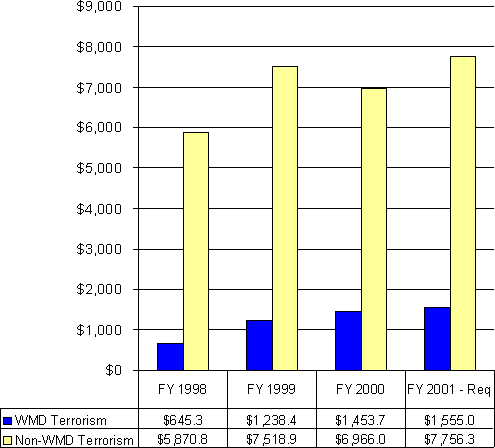
At the other end of the task spectrum for HHS is mental health response to terrorist incidents, both real and threatened, which has not received the support it should. How to manage the problem of the “worried well” and the mental trauma American society might experience in the event of a catastrophic terrorist attack deserves greater priority and financial support. The Tokyo subway attack and other mass casualty terrorist attacks suggest that hospitals will need to deal with many multiples more people with psychosomatic disturbances than physical injuries.
How to manage the onslaught of the psychosomatic and psychologically injured public must be addressed if the health system has any chance of treating the physically wounded. Our official communication about the threat of terrorism, particularly WMD terrorism, has increased rather than reduced concern. Anthrax hoaxes dramatically increased in the United States after the initial Nunn-Lugar-Domenici local responders training sessions began, as Secretary of Defense Cohen held up a bag of sugar at a news conference to indicate how little anthrax would be needed to kill thousands in a city, and as a result of the government’s poorly handled detention of Larry Wayne Harris, who had anthrax vaccine in the back of his car. More sober official communications about the potential danger of WMD terrorism and our preparations might have limited the tremendous increase in unconventional weapons threats and hoaxes. The vastly different strategies in New Jersey and New York for dealing with the West Nile virus suggest that effective communication with the public about the nature of an outbreak can mean the difference between creating public concern and maintaining public order and confidence. [26]
4. R&D Spending
R&D spending poses the greatest long-term policy challenge. The search for future tools to address the full range of terrorist threats, particularly those stemming from the use biological weapons, is critical. But given the time required for new technologies to mature, special care must be taken to ensure that each yearly research dollar contributes to future technological advancements.
The R&D spending related to weapons of mass destruction (WMD) deserves special attention (See Figure 5). There are significant differences in how the OMB annual reports depicted R&D spending from one year to another. The 1999 OMB Annual Report, for example, lists very different figures for the Department of Energy R&D spending than those listed in the 2000 OMB Annual Report for the same years.
Figure 5: R&D for Defense Against WMD Terrorism ($ in Millions)
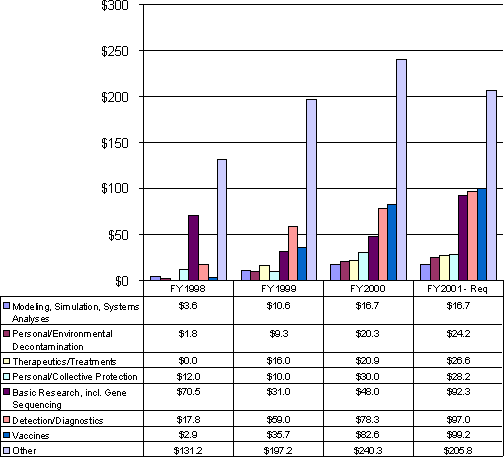
Finally, the R&D spending category of “Other” has consistently outpaced all other mission categories. Some means of characterizing the variety of activities covered by the “Other” R&D category must be found. Proper oversight of the R&D budget is difficult without greater detail.
5. Managing Rapid Budget Increases
The President and the Congress responded rapidly to the prospect of an increase in terrorist activity on American soil and the potential use of unconventional weapons materials. In several instances, government departments and agencies received significant budget increases to “stand up” important programs. The Departments of Health and Human Services has received enormous increases in budget authority for antiterrorism and counterterrorism programs in the last few years. Managing such rapid increases in funding is bound to present formidable challenges.
A thorough review of the three or four government programs that received the most significant percentage increases is important to the integrity of the government’s overall effort (See Figures 6 and 7). Challenges about the propriety of the increases and their effective allocation could stall important programs at a crucial stage of development. Alternatively, if fast growing programs have gone off track, it is important to identify these problems before sunk costs drive spending decisions more than wise policy.
Figure 6: Funding to Combat Terrorism, Including WMD by Mission Area ($ in Millions)
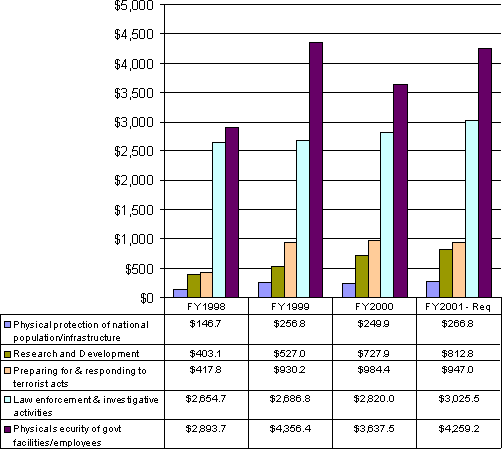
Figure 7: Funding to Combat Terrorism, Including WMD by Agency ($ in Millions)
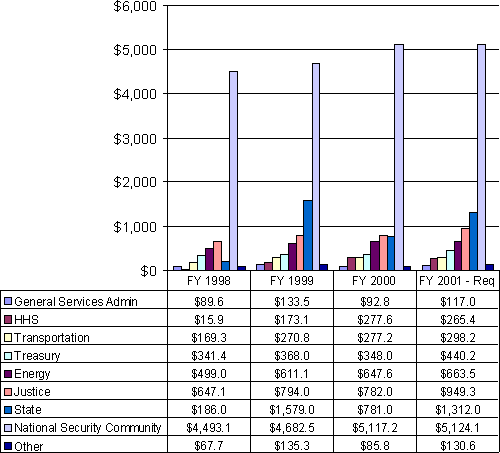
6. Funding the Department of Justice’s National Domestic Preparedness Office
PDD-62 designates the Department of Justice (DOJ) as the lead agency for handling domestic terrorism crisis. While allocation of financial resources is not the only way to indicate policy priorities, the lack of support for DOJ’s terrorism offices is conspicuous by its absence. The 2000 OMB Annual Report does not discuss the National Domestic Preparedness Office (NDPO) in any meaningful detail. Appropriately, the task of local and state responder training will transition from the military as designated by earlier Nunn-Lugar-Domenici legislation to the DOJ’s NDPO. Based on questions regarding the NDPO’s funding and its operational pace, neither the executive branch nor the Congress seems to have fully endorsed the mission of this new office. This sends exactly the wrong signal to State and Local officials at precisely the moment they look to the Federal government to bring some leadership to this daunting new challenge.
V. Other Nations’ Approaches to Combat Terrorism
The GAO’s report on other nation’s approaches to combating terrorism is a valuable contribution to improve the formulation and implementation of a national terrorism policy. [27] Examining the policies and practices of other nations, particularly those with experience who have suffered a greater number of terrorist attacks than the United States, is valuable. The most important finding of the report that should inform our national approach to the problem is how other countries view the terrorism threat in context. The nations survey by the GAO all took into account the likelihood of an attack and did not focus as intensively on vulnerabilities. They adapt their intelligence, physical protection measures, and law enforcement activities to the changing nature of the threat. Vulnerabilities are taken into account, but the likelihood that terrorists will exploit vulnerabilities is a significant component of their preparation.
Given the greater historical experience with terrorism on their national territory, the publics of the countries surveyed accept periodic casualties without a significant loss in public confidence of the government. In the United States, we aim as a society to take whatever measures deemed appropriate to protect our entire territory, every citizen, and all public and private facilities from any and all malicious and intentional attack. Our national desire for protection against ballistic missiles is another expression of this desire that is not shared to the same degree by other nations, including many of our key allies. Furthermore, more Americans die from alcohol related traffic accidents or food-borne illness than terrorist incidents. Political support has not surged to ensure that the government take meaningful actions to reduce these casualty rates.
Taking note of the limitations of such an analysis will help American policy put this international comparison in perspective. While the GAO clearly indicates that they did not conduct a comparative study, the value of their findings lies in the potential for comparison with the United States. At this moment, the United States stands as the preeminent power with global influence and responsibilities. The countries considered in the GAO analysis are regional powers. As the sole global power the United States attracts admiration, envy and antipathy. Periodically, the US government, American companies and American citizens may be a terrorist target for no other reasons than the perception of the country’s global power.
Second, two of the countries included in the GAO analysis, Israel and the United Kingdom, struggle with acute terrorism problems stemming from their presence on disputed territories. American forces stationed abroad face a somewhat similar threat environment, but it is not nearly as acute or as constant. The security environments in the Middle East and Northern Ireland have changed in the last few years due to improvements in the political dialogues of the parties concerned. The United States does not face any analogous circumstances that could lead to a significant lessening of the terrorist threat.
Conclusion
A comprehensive threat assessment that integrates information on both domestic and international terrorist threats is an essential baseline tool for informing a national strategy on terrorism, which the US currently lacks. At the moment, far too much of the government’s policy on terrorism is driven by perceptions of vulnerability and planning for worst-case scenarios. Inordinate attention to vulnerabilities and worst-case scenarios may be skewing resources in ways that do not effectively add to the government’s effort to protect our personnel and facilities, private businesses, and citizens at home and abroad. Producing a comprehensive and integrated national threat assessment that takes into account vulnerabilities to attack as well as the capabilities and motivations of terrorists will improve our national understanding of the threat and should inform the President and the Congress as they decide upon investments in short and long term programs to combat terrorism.
Sources:
[1] U.S. General Accounting Office. Combating Terrorism: Observations on Federal Spending to Combat Terrorism. Statement of Henry L. Hinton, Jr., Assistant Comptroller General, National Security and International Affairs Division, Before the Subcommittee on National Security, Veterans Affairs, and International Relations, Committee on Government Reform, U.S. House of Representatives, March 11, 1999, p. 13.
[2] Bruce Hoffman, “The Debate over Future Terrorist Use of Chemical, Biological, Radiological and Nuclear Weapons,” in Hype or Reality?: The “New Terrorism” and Mass Casualty Attacks, ed. Brad Roberts, (Alexandria, VA: The Chemical and Biological Arms Control Institute, 2000), p. 220.
[3] DCI National Intelligence Estimate President’s Summary, “Emerging Missile Threats to North America During the Next 15 Years,” PS/NIE 95-19, November 1995, www.fas.org, accessed July 24, 2000. “NIE 95-19: Independent Panel Review: Emerging Missile Threats to North America During the Next Fifteen Years,” OCA 96-1908, December 23, 1996, www.fas.org, accessed July 24, 2000, (hereafter referred to as the Gates Panel). Report of the Commission to Assess the Ballistic Missile Threat to the United States, Pursuant to P.L. 201, 104th Congress, July 15, 1998, (hereafter referred to as the Rumsfeld Commission.) National Intelligence Council, Foreign Missile Developments and the Ballistic Missile Threat to the United States Through 2015, September 1999.
[4] National Commission on Terrorism, Countering the Changing Threat of International Terrorism, June 2000 (Hereafter referred to as “The National Commission Report”). First Annual Report to the President and the Congress of the Advisory Panel to Assess Domestic Response Capabilities for Terrorism Involving Weapons of Mass Destruction, (hereafter referred to as the Gilmore Commission Report), I. Assessing the Threat, December 15, 1999.
[5] National Park Service, Report to Congress pursuant to P.L. 105-391 National Parks Omnibus Management Act 1998, “Law Enforcement Programs Study: United States Park Police,” March 8, 2000, pp. 13-15.
[6] Arthur Santana, “Monuments Are Found Vulnerable to Attack,” Washington Post, July 2, 2000, p. A1.
[7] For a recent study of the incidents of chemical and biological weapons terrorism frequently cited in the scholarly literature see, Jonathan B. Tucker, ed., Toxic Terror: Assessing Terrorist Use of Chemical and Biological Weapons, (Cambridge, Massachusetts: MIT Press, 2000). For a summary of intelligence community rankings of terrorism threats see, U.S. General Accounting Office, “Combating Terrorism: Need for Comprehensive Threat and Risk Assessments of Chemical and Biological Attacks,” (GAO/NSIAD-99-163), September 1999.
[8] The Gilmore Commission Report, p. 21.
[9] A CIA Middle East specialist offer wise commentary on this topic just prior to the year 2000 celebration: Reuel Marc Gerecht, “Alarm Abets the Terrorists,” New York Times, December 23, 1999, p A-29.
[10] Michael Dobbs, “Key Player in U.S. Terror War,” Washington Post, April 2, 2000, p. A1.
[11] Annual Report to Congress on Combating Terrorism, “Including Defense Against Weapons of Mass Destruction/Domestic Preparedness and Critical Infrastructure Protection,” May 18, 2000 (hereafter “The 2000 OMB Annual Report”).
[12] The 2000 OMB Annual Report, p. 6.
[13] The Gilmore Commission Report, pp. 53-55.
[14] Monterey Institute’s Center for Nonproliferation Studies website, July 24, 2000.
[15] The two earlier versions of the OMB Annual Report were the following: The Office of Management and Budget report pursuant to P.L. 105-85, Government-wide Spending to Combat Terrorism, March 12, 1998 (hereafter: The Office of Management and Budget report pursuant to P.L. 105-85, March 3, 1999. (Hereafter these reports will be referred to respectively as The 1998 OMB Annual Report and the 1999 OMB Annual Report).
[16] The 2000 OMB Annual Report, p. 3.
[17] See The 1999 OMB Annual Report, p. 6.
[18] The 2000 OMB Annual Report, p. 48.
[19] The National Commission Report, p. 36.
[20] The Gilmore Commission, pp. 40-50. See also, Milton Leitenberg, “The Experience of the Japanese Aum Shinryko Group and Biological Weapons,” in Hype or Reality? The “New Terrorism” and Mass Casualty Attacks, ed. Brad Roberts, (Alexandria, VA: The Chemical and Biological Arms Control Institute, 2000), pp. 159-172.
[21] The 2000 OMB Annual Report, p. 11.
[22] The 2000 OMB Annual Report, p. 13.
[23] The 2000 OMB Annual Report, p. 53.
[24] Report of the Accountability Review Boards, “Bombings of the US Embassies in Nairobi, Kenya and Dar es Salaam, Tanzania,” August 7, 1999, www.state.gov, accessed October 18, 1999.
[25] The 2000 OMB Annual Report, p. 10.
[26] Matthew Purdy, “Public Health Meets Public Relations in Battle Against Mosquitoes, New York Times, p. 19.
[27] “Combating Terrorism: How Five Foreign Countries Are Organized to Combat Terrorism,” U.S. General Accounting Office (GAO/NSIAD-00-85), April 2000.
